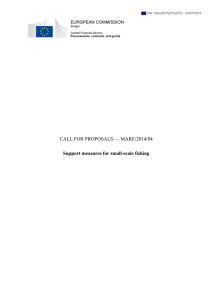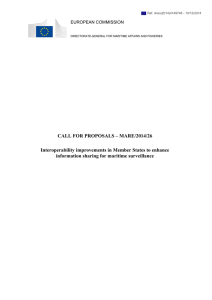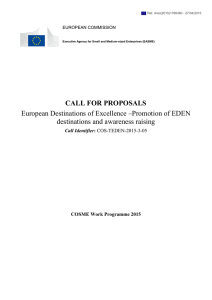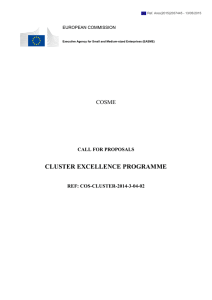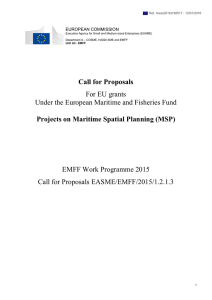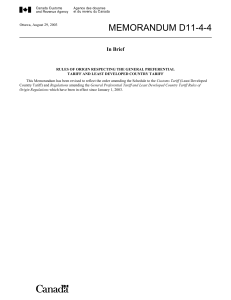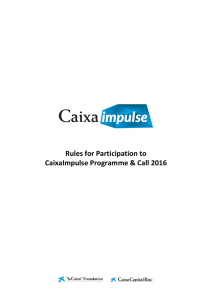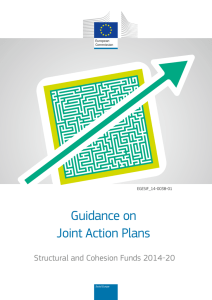Supporting the businesses` expansion in the Internal Market by
Anuncio
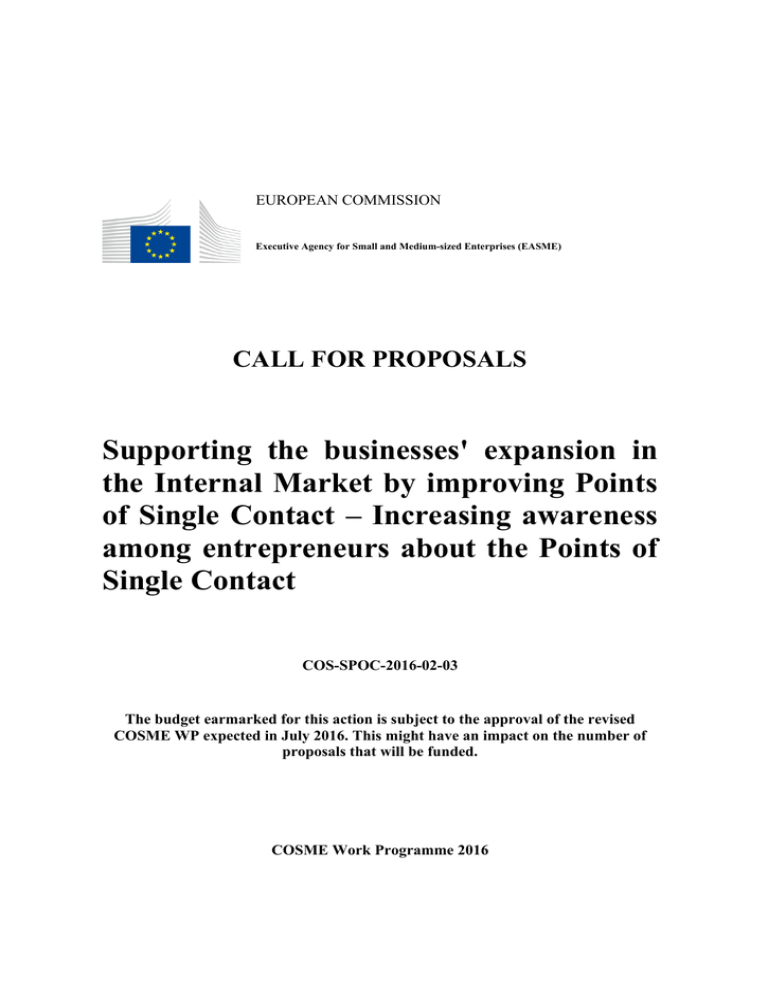
EUROPEAN COMMISSION
Executive Agency for Small and Medium-sized Enterprises (EASME)
CALL FOR PROPOSALS
Supporting the businesses' expansion in
the Internal Market by improving Points
of Single Contact – Increasing awareness
among entrepreneurs about the Points of
Single Contact
COS-SPOC-2016-02-03
The budget earmarked for this action is subject to the approval of the revised
COSME WP expected in July 2016. This might have an impact on the number of
proposals that will be funded.
COSME Work Programme 2016
Table of Contents
1.
INTRODUCTION AND POLICY SECTION ............................................ 4
1.1.
Introduction ................................................................................................. 4
1.2.
Policy Context ............................................................................................. 4
1.2.1.
General policy context ................................................................................. 4
2.
OBJECTIVE(S) – THEME(S) – ACTIVITIES – OUTPUTS .................... 6
2.1.
General objectives ....................................................................................... 6
2.2.
Specific objectives ....................................................................................... 7
2.3.
Eligible activities ......................................................................................... 7
2.4.
Expected results ........................................................................................... 8
2.5.
General indicators........................................................................................ 9
3.
TIMETABLE ............................................................................................ 11
4.
BUDGET AVAILABLE AND FUNDING OF PROJECTS .................... 11
5.
ADMISSIBILITY REQUIREMENTS ...................................................... 11
6.
ELIGIBILITY CRITERIA ........................................................................ 12
6.1.
Eligible applicants ..................................................................................... 12
6.2.
Eligible consortia ....................................................................................... 12
6.3.
Eligible proposals ...................................................................................... 13
7.
EXCLUSION CRITERIA ......................................................................... 13
8.
SELECTION CRITERIA .......................................................................... 13
8.1.
Financial capacity ...................................................................................... 13
8.2.
Operational capacity .................................................................................. 14
9.
AWARD CRITERIA ................................................................................ 14
10.
LEGAL COMMITMENTS ....................................................................... 16
11.
ADMINISTRATIVE REVIEW PROCEDURES ..................................... 16
12.
FINANCIAL PROVISIONS ..................................................................... 17
12.1.
General principles...................................................................................... 17
12.2.
Funding forms ........................................................................................... 18
12.3.
Payment arrangements............................................................................... 22
12.4.
Pre-financing guarantee ............................................................................. 22
13.
PUBLICITY .............................................................................................. 23
13.1.
By the beneficiaries ................................................................................... 23
2
13.2.
By EASME ................................................................................................ 23
14.
DATA PROTECTION .............................................................................. 23
15.
PROCEDURE FOR THE SUBMISSION OF PROPOSALS ................... 24
3
1.
1.1.
INTRODUCTION AND POLICY SECTION
Introduction
Small and medium-sized enterprises (SME) play a crucial role in reaching the objectives
of the Europe 2020 Strategy1. Whereas they are considered as crucial engines for growth
and job creation, their competitiveness is affected by a limited exploitation of
international opportunities and innovation prospects in the Single Market and beyond.
In this context, the Programme for the competitiveness of enterprises and small and
medium-sized enterprises (2014-2020)2, hereinafter referred to as “COSME”, aims to
promote growth and to strengthen the competitiveness and sustainability of enterprises in
the European Union.
This call for proposals implements part of the COSME Work Programme 20163.
The Executive Agency for Small and Medium-sized Enterprises4 (hereinafter referred to
as "EASME" or the "Agency") manages this call for proposals. EASME is, inter alia,
entrusted by the European Commission with the implementation, inter alia, of parts of
the COSME programme.
1.2.
1.2.1.
Policy Context
General policy context
The Services Directive5 was adopted with a view to facilitate the creation of the Single
Market for services. The directive called on Member States to establish Points of Single
Contact (PSC) in order to support companies to seize the business opportunities in the
EU marketplace. The Points of Single Contact are e-government portals which provide
information on administrative requirements and access to online procedures to complete
online the necessary formalities linked to the permission or to the licence that the
entrepreneur needs to obtain, in order to be able to provide the specific service in their
own or in another Member State. Though the Points of Single Contact are considered as
one of the success stories of the Services Directive, their potential is not fully exploited.
The European Parliament and the Council regularly call on the Commission and Member
States to develop Points of Single Contact further. The European Parliament’s Report on
the Single Market governance within the European Semester 20166 regrets that further
implementation of the Services Directive, covering activities representing more than 45
% of the EU’s GDP and employment, is hindered by a multitude of varying national rules
and regulations and that the notification procedure is often not complied with. The
Report advises that a strengthened role for the existing Points of Single Contact as single
1
COM (2010)2020 final of 3 March 2010 “Europe 2020. A strategy for smart, sustainable and inclusive growth”.
2
Regulation (EU) No 1287/2013 of 11 December 2013 (Official Journal of the European Union L 347/33 of 20.12.2013).
3
Commission Implementing Decision C(2016) 63 final of 18 January 2016 on the adoption of the work programme for 2016 and the
financing for the implementation of the Programme for the Competitiveness of Enterprises and small and medium-sized enterprises.
4
EASME was set up by Commission Implementing Decision 2013/771/EU of 17 December 2013 establishing the Executive Agency
for Small and Medium-sized Enterprises and repealing Decisions 2004/20/EC and 2007/372/EC (Official Journal of the European
Union L 341/73 of 18.12.2013).
5
Directive 2006/123/EC of 12 December 2006 (Official Journal of the European Union L 376/36 of 27.12.2006).
6
Report of 1 February 2016 on the Single Market governance within the European Semester 2016(2015/2256(INI)),
http://www.europarl.europa.eu/sides/getDoc.do?pubRef=-//EP//NONSGML+REPORT+A8-2016-0017+0+DOC+PDF+V0//EN.
4
access points for Single Market issues for economic operators will help raise awareness
and understanding of the applicable legislation.
The Competitiveness Council conclusions on Single Market Policy of March 20157
called for political commitment "to strengthen and streamline Single Market tools, such
as Points of Single Contact, Product Contact Points (PCPs), the SOLVIT system, the IMI
(Internal Market Information System) and Your Europe, in order to better meet the needs
of businesses and citizens in their cross-border activities".
This message was repeated by the Competitiveness Council meeting on 29 February
20168, which recalled the importance of strengthening and streamlining existing Single
Market tools for SMEs, in order to simplify and facilitate their cross-border activities and
expansion. In this context, the Council emphasized the urgent need for improvement of
EU-related business contact points, including further improvement of the Points of Single
Contact, in line with the Points of Single Contact Charter.
In order to address these concerns, two specific policy objectives have been included into
the COSME Work Programme for 2016: Increase user-friendliness of Points of Single
Contact by the testing of their portals by business (user testing) and improving awareness
of the Points of Single Contact among the business community.
The present call for proposals aims at implementing the second policy objective by
co-financing projects to be undertaken by the national authorities responsible for
the managing of the Points of Single Contact.
1.2.2. SPECIFIC POLICY CONTEXT
The study "The functioning and usability of the Points of Single Contact under the
Services Directive – State of Play and Way Forward Final report"9, which was carried in
2012, stresses that the awareness of the Points of Single Contact was low in all Member
States. According to the majority of stakeholders interviewed, awareness and promotion
campaigns would be needed in order to improve the degree of recognition of the portals
of Points of Single Contact, as well as volumes of use. Only 30% of the focus group
participants were aware of the Points of Single Contact prior to contributing to the focus
group meeting and there were no significant differences in the awareness between the
different Member States. All the Points of Single Contact were perceived as official
portal sites backed by the government. This was reinforced by the presence of the EUGO
logo on all of the Points of Single Contact. All the EUGO logos link to the EUGO site,
where links can be found towards all Member State portals. However, no national portals
contained direct links to other Member States' portals. The search engine rankings of the
Points of Single Contact were poor in over half of the countries, but good in Denmark,
Luxembourg, Malta, Portugal, and the United Kingdom. In general, the term “Point of
Single Contact” yielded the best result for most portals for two search engines. However,
other terms, such as “One-stop shop” and “e-government for business” did not rank well.
In most cases, when searched for, they were to be found beyond the 50th ranked site.
Improved awareness shall be pursued by promotion efforts (focusing mainly online and
including e.g. targeted online advertising campaigns and search engine optimisation),
7
6715/15Council (Competitiveness, Internal Market, Industry, Research and Space), Brussels, 2 and 3 March 2015, 6715/15,
OUTCOME OF THE COUNCIL MEETING, http://data.consilium.europa.eu/doc/document/ST-6715-2015-INIT/en/pdf
8
6622/16Council (Competitiveness), Brussels, 29 February 2016; http://data.consilium.europa.eu/doc/document/ST-6622-2016INIT/en/pdf
9
http://ec.europa.eu/internal_market/services/docs/services-dir/study_on_points/final_report_en.pdf
5
outreach activities to SMEs, especially those active across borders, and joint projects
with business support organisations, where possible, in collaboration with Enterprise
Europe Network (http://een.ec.europa.eu/) partners.
No previous measures were taken through COSME funding on improving awareness at
EU level as regards the Points of Single Contact. Member States' efforts in this respect
remain scattered and are rarely coordinated in order to achieve broader impact.
Therefore, action is needed for raising awareness among businesses about the
services offered by the Points of Single Contact. This action will fill this gap and
contribute to the better functioning of the Points of Single Contact by improving their
visibility and thereby making it easier for companies that want to provide their service
cross-border to receive information and comply with administrative requirements. This
will broaden the access of companies active in the services sector to other EU markets.
This action shall be carried out by or in agreement with the authorities responsible for the
Points of Single Contact and should target entrepreneurs, in particular SMEs which have
bigger potential for expanding to other EU markets. This action can be performed in
cooperation with business support organisations (e.g. chambers of commerce) in order to
increase their awareness about the role and services provided by the Points of Single
Contact.
2.
2.1.
OBJECTIVE(S) – THEME(S) – ACTIVITIES – OUTPUTS
General objectives
The objective of the present call for proposals is to promote the Points of Single Contact
and the services they provide to entrepreneurs wanting to explore the potential offered by
the Internal Market.
Cooperation with business support organisations such as Enterprise Europe Network,
Chambers of Commerce and other organisations, which have in their remit the
responsibility to carry out information activities targeting SMEs (especially those active
across borders) will be seen as an advantage.
The awareness raising projects shall target entrepreneurs as well as business support
organisations, since they are an important source of information for businesses and can
direct them to PSCs. It is important to note that business support organisations might
however also be directly involved in the project as partners in the consortium (see below
point 6.2).
The present call for proposals aims therefore at achieving the following general
objectives:
create better conditions for SMEs' expansion in the Internal Market.
raise awareness of the Points of Single Contact among the European businesses
and entrepreneurs so that they know where to turn for information, assistance or
interact with public administrations in order to get established or provide services
in the EU.
6
raise awareness among business support organisations of the PSCs’ role and their
offer, so that they can provide comprehensive advice to their members or
partners.
2.2.
Specific objectives
The specific objectives of the present call are to:
encourage businesses, including those established in a different Member State or
wishing to provide services across borders, to make use of PSCs in order to
complete administrative procedures online or seek assistance.
foster cooperation between the PSCs established in different Member States so
that they can cross-refer to services provided by them (relevant advice and
guidance for businesses from another Member State.)
improve cooperation between PSCs and other business support organisations in a
given Member State or from different Member States so that they can make
maximum use of their comparative advantages and complement each other's
services.
increase the number of visits on the PSCs' portals (number of users)
increase online 'findability' of the PSCs through a higher indexation of PSC
portals on search engines.
DEFINITIONS
SME is defined, for the purposes of this call, as in the Commission Recommendation of 6
May 2003 concerning the definition of micro, small and medium-sized enterprise,
(2003/361/EC)10
Business support organisations are defined, for the purposes of this call, as private, public
or semi-public entities established in accordance with the respective national law, with a
purpose to provide businesses with assistance (information or advice) during their business
life cycle.
Public authorities responsible for the management of the PSCs are defined, for the
purposes of this call, as authorities responsible for implementation of Article 6 ‘Points of
Single Contact’ of Directive 2006/123/EC11.
2.3.
Eligible activities
Given the expected impacts and outcomes of the awareness raising campaign, applicants
must propose an awareness raising campaign covering at least 2 different Member States,
including the country of the consortium coordinator and clearly indicating the activities
proposed to reach its targets.
10
11
http://eur-lex.europa.eu/legal-content/EN/TXT/?uri=CELEX:32003H0361
Directive 2006/123/EC of 12 December 2006 (Official Journal of the European Union L 376/36 of 27.12.2006)
7
The awareness raising campaign shall be presented through a detailed description of
activities and its methodology should be explained in detail.
It is proposed to the applicants to design and implement a coherent awareness
raising campaign in order to increase visibility of the Points of Single Contact.
Proposals shall indicate the most effective activities to develop and implement the
proposed information strategy. Applicants are free to propose the activities they consider
relevant. However, it is essential that all activities clearly aim at achieving the outcomes
indicated in point 2.3.4.
The proposals must include, as a minimum, the following two "core" activities:
1) Design and develop an awareness raising campaign to promote Points of Single
Contact to the potential users.
2) Measure and evaluate the outcomes of the communication activities and suggest
recommendations on the basis of the gathered feedback.
Examples of promotion activities that can be carried out are:
design and implementation of search engine optimisation
inserting information on PSCs into internet sites, using online advertising
services, mobile devices and web-based marketplace of business support
organisations, online quizzes
introducing a system of cross referrals between relevant PSCs
social media outreach (drafting posts and building partnerships on social network
service websites)
promotion of PSCs in classic and social media (e.g. issuing newsletters, press
releases and publications of articles in the press, organisation of pressconferences, briefings for journalists, broadcasting of the available audio-visual
material)
organisation of workshops/seminars/trainings
development of promotional materials (e.g. information leaflets, brochures,
posters, roll-ups, take-away gadgets, films) for participation at the abovementioned events
development/maintenance of specialised PSCs websites targeting businesses from
other Member States – if different from the PSC targeting businesses from the
domestic market.
This list is non exhaustive and only aims at providing guidance to the applicants.
Applicants may propose any other action they deem necessary to achieve the objectives
of the call, provided that they well justify their choice and clearly describe the link
between the proposed actions and the objectives to achieve.
2.4.
Expected results
The expected impact of the awareness raising campaign is to increase knowledge about
the Points of Single Contact among businesses during the implementation of the project.
8
It is assumed that the project impacts can be achieved if the awareness raising campaign
is able to deliver the following results:
increased number of visits on PSCs' website
higher ranking of the concerned PSCs in search engine results in the language(s)
of the concerned PSCs
improved awareness of PSCs in the business community
increased number of procedures filled in online through the PSCs
strengthening of cooperation between PSCs or between PSCs and business
support organisations
2.5.
General indicators
1) Number of PSCs organising awareness raising activities
2) For online promotional activities: relevant statistics on web traffic (e.g. a web
analytics service) and search engine rankings
3) Number of entrepreneurs and business support organisations reached
4) Increase of the number of contacts/requests for information or assistance from the
target groups to the relevant PSC
5) Number of events (conference, workshops, seminars) organised to increase the
awareness about the PSCs and number of participants. Feedback on the quality of
the events
Applicants shall propose additional specific key indicators for each activity to be
implemented and a methodology to measure the outcomes at the end of the project.
2.6.
General principles
2.6.1.
Guiding Principles for the preparation of the proposals
Be clear. In order to ensure good structuring and clarity of the project, applicants are
requested to divide the actions into Work Packages, having clear objectives, a clear
description of the work, deliverables, milestones, and expected results measured by
performance indicators. To do so, partners must fill in the template "Description of
Work", provided together with the call.
Be coherent. The proposal should clearly elaborate – among others - on the
following aspects:
a) Shortcomings and specific needs to be addressed;
b) Identification of the target group and its justification/rationale;
c) Logic link between identified needs, specific objectives, proposed actions and expected
results;
d) Complementarity of the project with other actions being taken (if any) by the applicants.
a)
b)
c)
d)
Be supported by a short but robust action plan. The proposal should briefly
elaborate – among others - on the following aspects:
Status quo (SWOT or similar) analysis of the current situation;
Identification of needs the project wants to address;
Description of and reasons for the chosen solution as proposed in the project proposal;
The extent to which the outputs are likely to lead to clear and tangible results;
9
e) Estimated impact of the proposed actions on target groups and on the local economies of
targeted areas (indicators, data sources, tools and methodologies to measure short and
medium-long term benefits/impact of proposed actions);
f) Any evidence of transformative or spill-over effects, including the extent to which
additional value is or could be created by its adoption more widely across Europe.
Be technically and financially sustainable. The project proposal should identify the
management structure and explain how this will enable the project to meet its goals.
It should also identify the staff to be involved and the distribution of tasks between
partners and staff members.
Generate real measurable results and long-term effects. The expected results of
the project should be clearly outlined (both short–term and medium-long-terms
results) and they should be quantifiable and measurable. The proposal should indicate
how the results can be measured (i.e. which indicators and sources can be used to
measure the results, also after the end of the project).
The description of the project shall follow the structure indicated in the Technical Annex
1 – Description of the Action (see Annex 2).
-
-
2.6.2.
The description of the project should contain:
an estimation of the related costs in cash and in kind (in any)
identification of the target audience (including geographic focus). The applicants
shall be able to assess the potential reach of their strategy
brief description of the main messages of the strategy, its creativity (i.e. how to
bring the message across). The ultimate goal is to make the target audience
clearly understand the role and services provided by the Points of Single Contact
in order to be able to use them more effectively
explanation of how the campaign will deliver the intended outcomes, which
indicators and methodology will be used to measure the impacts and outcomes of
the project. It is important that the proposal contains at least a first set of the
indicators as reference of the starting point
Reporting obligations
1 progress report midway through the project, including at least a description of the
activities undertaken, the results achieved, and obstacles encountered and mitigating
measures adopted. The progress report should be of maximum 5 pages
1 final technical report (including all deliverables) and 1 final financial report
including a consolidated statement and a breakdown between each beneficiary (art.
15.4 of the Grant Agreement);
Reports must be submitted by the coordinator in English.
2.6.3.
Kick-off meeting
The applicant must foresee, in the budget proposal of the project, the participation of
maximum two representatives of the project’s consortium (including at least one
representative of the coordinator organisation) at the kick-off meeting in Brussels, organised
by EASME, at the beginning of the implementation period and usually at the latest within the
first two weeks after the signature of the agreement.
10
3.
TIMETABLE
Stages
Dates
a) Deadline for submitting applications
(08/09/2016) 17:00h Brussels time
b) Evaluation period*
(September-October 2016)
c) Information to applicants*
(November 2016)
d) Signature of grant agreements*
(December 2016)
e) Starting date of the action*
(January 2017)
* indicative
4.
BUDGET AVAILABLE AND FUNDING OF PROJECTS
The total budget earmarked for the co-financing of projects is estimated at EUR 300 000.
The maximum amount per project will be EUR 75 000.
EASME expects to fund approximately 4 project proposals.
The grant is limited to a maximum reimbursement rate of 75% of eligible costs.
EASME reserves the right not to distribute all the funds available.
The budget earmarked for this action is subject to the approval of the revised COSME
WP expected in July 2016. This might have an impact on the number of proposals that
will be funded.
5.
ADMISSIBILITY REQUIREMENTS
The following requirements must be complied with:
applications must be submitted no later than the deadline for submitting
applications referred to in section 3;
applications must be submitted using the electronic system specified in section
14;
applications must be drafted in one of the EU official languages.
Failure to comply with those requirements will lead to the rejection of the application.
11
6.
ELIGIBILITY CRITERIA
6.1.
Eligible applicants
Applicants must be legal entities. In the event of private bodies, they must be properly
constituted and registered under national law.
Applicants and all consortium members must fall under the following categories:
a) public authorities responsible for the management of a PSC at national or regional
level, in case the responsibility for the PSC is decentralised in a given country;
b) private or semi-private entities which have been entrusted by public authorities
(see a) to manage the PSC;
c) public authorities active in the area linked to the activities of the PSCs (i.e.,
authorities responsible for e-government);
d) private or semi-private entities, other than the ones mentioned in point (b) active
in the area linked to the activities of the PSCs, such as chambers of commerce
and industry, chambers of handicrafts or similar bodies or their networks or
associations;
e) training or educational institutions including universities or research centres
active in the field related to the provision of services or of e-government.
Only applications from legal entities established in the following countries are eligible:
-
6.2.
EU Member States;
countries participating in the COSME programme pursuant to Article 6 of the
COSME Regulation12.
Eligible consortia
Proposals shall be submitted by consortia composed of at least two of the eligible
applicants referred to in point 6.1 a) or b), from at least two different COSME eligible
countries.
One of the consortium members must act as the consortium coordinator.
Applicants may participate in more than one consortium, but may act as project
coordinator in only one submitted proposal. Should an applicant act as project
coordinator in more than one proposal, all proposals submitted by the same coordinator
will be excluded13.
12
The following groups of countries are eligible for participation in COSME:
a) European Free Trade Association (EFTA) countries which are members of the European Economic Area (EEA), in accordance
with the conditions laid down in the EEA Agreement, and other European countries when agreements and procedures so allow;
b) acceding countries, candidate countries and potential candidates in accordance with the general principles and general terms and
conditions for the participation of those countries in the Union's programmes established in the respective Framework Agreements
and Association Council Decisions, or similar arrangements;
c) countries falling within the scope of the European neighbourhood policies, when agreements and procedures so allow and in
accordance with the general principles and general terms and conditions for the participation of those countries in the Union's
programmes established in the respective Framework Agreements, Protocols to Association Agreements and Association Council
Decisions.
The updated list of eligible third countries is available on the following webpage:
http://ec.europa.eu/growth/smes/cosme/index_en.htm
13
Consortium coordinators are requested to take appropriate measures to ensure that their organisation does not act as coordinator in
other proposals under this call.
12
For this reason, an explicit declaration will have to be submitted by each coordinator and
included in the proposal (see Annex 6).
In order to assess the applicants' eligibility, the following supporting documents are
requested in case the applicant is a private entity: one or more letters of support to the
project delivered by a public authority of the eligible country, namely a Ministry at national
level or a Ministry at regional level in charge of the implementation of Articles 6 – 8 of the
Services Directive.
6.3.
Implementation period
- activities are to be completed by 31 December 2017
- the maximum duration of projects is 4-6 months.
Applications for projects scheduled to run for a longer period than that specified in this
call for proposals will not be accepted.
7.
EXCLUSION CRITERIA
All applicants shall provide a declaration on honour (see Annex 7) signed and dated by
an authorised representative, stating that they are not in one of the situations of exclusion
listed in that declaration on honour.
The funding body reserves the right to verify whether the successful applicants are in one
of the situations of exclusion by requiring the supporting documents listed in the
declaration of honour.
8.
8.1.
SELECTION CRITERIA
Financial capacity
Applicants must have stable and sufficient sources of funding to maintain their activity
throughout the period during which the action is being carried out or the year for which
the grant is awarded and to participate in its funding. In case the applicant is a private or
a semi-private body, the applicants' financial capacity will be assessed on the basis of the
following supporting documents:
a) Low value grants (≤ EUR 60 000):
- a declaration on their honour.
b) Grants ≥ EUR 60 000:
- a declaration on their honour and,
EITHER
the profit and loss account, the balance sheet for the last financial year for
which the accounts were closed;
for newly created entities, the business plan might replace the above
documents.
OR
13
the table provided for in the application form, filled in with the relevant
statutory accounting figures, in order to calculate the ratios as detailed in
the form.
c) Grants for an action ≥ EUR 750 000, in addition:
- an audit report produced by an approved external auditor certifying the accounts
for the last financial year available.
The above-listed documents will have to be provided at later stage, via the electronic
submission tool, and only upon request of EASME.
In the event of an application grouping several applicants (consortium), the above
thresholds apply by applicants.
On the basis of the documents submitted, if the Responsible Authorising Officer (RAO)
considers that financial capacity is not satisfactory, he may:
request further information;
propose a grant agreement without pre-financing;
propose a grant agreement with a pre-financing paid in instalments;
propose a grant agreement with a pre-financing covered by a bank guarantee (see
section 12.4 below);
where applicable, require the joint and several financial liability of all the cobeneficiaries;
reject the application.
8.2.
Operational capacity
Applicants must have the professional competencies as well as appropriate qualifications
necessary to complete the proposed action.
In this respect, applicants have to submit the following supporting documents:
curriculum vitae (CV), preferably in European CV format
http://europass.cedefop.europa.eu) or description of the profile of the main
persons primarily responsible for managing and implementing the different
activities of the action;
a summary table indicating the persons that will make up the core team
responsible for the project with their qualifications and competences. A template
is included in the application forms;
if possible, a list of previous projects and activities performed and connected to
the policy field of the call or to the actions to be carried out;
9.
AWARD CRITERIA
Eligible applications will be assessed on the basis of the following criteria:
Criteria
Max.
score
1. Relevance of the actions in view of the objectives of the call
14
What is the importance of the proposed action in relation to EU policies and 30
priorities identified in the call?
To what extent are the actions proposed by the applicant strategically chosen
to meet the objectives of this call?
How relevant is the project proposed in view of the objectives of the call?
How well does the project fit with the expectations/needs of the identified
target group?
How strategically chosen are the project partners (relevance of the partners
to the project)?
To what extent do the proposed activities, composition of the partnership and
the selected target group(s) demonstrate a European added value?
Is there any complementarity between the proposed project and other actions
being taken at European level?
2. Quality of the proposed actions
30
How clear, coherent and ambitious is the work plan?
How appropriate, practical and innovative are the activities proposed
(including the internal plan of action/work packages)?
To what extent is the work plan clearly defined in terms of schedule,
milestones and deliverables?
Is there a logical link between identified needs, specific objectives, proposed
actions and expected results? Is this link well described and justified?
How suitable is the contribution of each partner to the activities proposed?
Is the level of effort (hours and budget) appropriate, per work package, per
task and per partner considering their skills and responsibilities?
To what extent can the methodology and management set up be effective and
ensure the high quality of the action proposed?
3. Impact on target audience
20
Is the proposal suggesting clear, realistic and practical impact indicators? To
what extent does the project contribute to creating a real, measurable impact
on the sectors concerned?
To what extent is the project likely to have a tangible impact on the target
groups?
Are the expected multiplying effects reasonable? To what extent does the
proposal include elements of follow-up and transferability (including lessons
15
learnt and good practices) at EU level?
Are concrete measures planned in order to ensure that the project can be
continued after the termination of EU funding?
4. Cost-effectiveness
20
To what extent the detailed budget is coherent with the work plan of the
proposal?
To what extent is the budget clear and detailed, as well as effective, to
implement the action? Does the breakdown of the budget, category by
category, offer a way of ensuring that the amount of the grant awarded is
reasonable in relation to the expected results?
To what extent is the proposed expenditure necessary for the implementation
of the project?
Do the expected results stand in a reasonable relationship to the amount of
the grant? Does the budget seem justified when compared to the expected
impact?
TOTAL 100
In order to be considered for funding, proposals will need to have passed an overall
threshold of 70% in terms of total score. In addition, thresholds of 50% will be applied to
each individual award criterion described above in order to ensure a consistent minimum
quality for all award criteria. Proposals will be ranked according to their total score.
10.
LEGAL COMMITMENTS
In the event of a grant awarded by EASME, a grant agreement drawn up in euro and
detailing the conditions and level of funding, will be sent to the beneficiary, as well as
the procedures in view to formalise the obligations of the parties.
Please note that the award of a grant does not establish an entitlement for subsequent
years.
The authorising officer may draw a reserve list of proposals that have passed the above
thresholds. In the event that the original budget of the action is increased or that selected
proposal(s) fail to conclude the grant agreement, a grant may be awarded to proposals
from the reserve list.
11.
ADMINISTRATIVE REVIEW PROCEDURES
Unsuccessful applicants may request the review of the admissibility and eligibility
procedures and the evaluation procedures with regard to their proposal as specified in
section V of the Guide for applicants.
16
12.
FINANCIAL PROVISIONS
12.1. General principles
a) Non-cumulative award
An action may only receive one grant from the EU budget.
In no circumstances shall the same costs be financed twice by the Union budget. To
ensure this, applicants shall indicate the sources and amounts of Union funding
received or applied for the same action or part of the action or for its functioning
during the same financial year as well as any other funding received or applied for
the same action.14
b) Non-retroactivity
No grant may be awarded retrospectively for actions already completed.
A grant may be awarded for an action which has already begun only where the
applicant can demonstrate the need to start the action before the grant agreement is
signed.
In such cases, costs eligible for financing may not have been incurred prior to the
date of submission of the grant application
c) Co-financing
Co-financing means that the resources which are necessary to carry out the action
may not be entirely provided by the EU grant. It may take the form of:
the beneficiary's own resources;
income generated by the action;
financial contributions from third parties.
d) Balanced budget
The estimated budget of the action is to be attached to the application form. It must
have revenue and expenditure in balance.
The budget must be drawn up in euros.
Applicants who foresee that costs will not be incurred in euros, are invited to use the
exchange rate published on the Info-euro website available at:
http://ec.europa.eu/budget/contracts_grants/info_contracts/inforeuro/inforeuro_en.cf
m.
e) Implementation contracts/subcontracting
Where the implementation of the action requires the award of procurement contracts
(implementation contracts), the beneficiary must award the contract to the bid
offering best value for money or the lowest price (as appropriate),avoiding conflicts
of interests and retain the documentation for the event of an audit.
In the event of procurement exceeding EUR 60 000, the beneficiary must abide by
special rules as referred in the grant agreement annexed to the call. Moreover the
14
Directive 2004/18/EC of 31 March 2004 on the coordination of procedures for the award of public work contracts, public supply
contracts and public service contracts (Official Journal of the European Union L 134/114 of30.04.2004) or Directive 2014/24/UE of
26 February 2014 on public procurement and repealing Directive 2004/18/EC (Official Journal of the European Union L 94 of
28.3.2014, p.65)..
17
beneficiary is expected to clearly document the tendering procedure and retain the
documentation for the event of an audit.
Entities acting in their capacity of contracting authorities in the meaning of Directive
2004/18/EC (or Directive 2014/24/EU) 15 or contracting entities in the meaning of
Directive 2004/17/EC (or Directive 2014/25/EU)16 shall abide by the applicable
national public procurement rules. The beneficiary is expected to clearly document
the tendering procedure and retain the documentation for the event of an audit.
Sub-contracting, i.e. the externalisation of specific tasks or activities which form part
of the action as described in the proposal must satisfy the conditions applicable to
any implementation contract (as specified above) and in addition to them the
following conditions:
it may only cover the implementation of a limited part of the action;
it must be justified having regard to the nature of the action and what is
necessary for its implementation;
it must be clearly stated in the proposal.
f) Financial support to third parties.
Applications may not envisage provision of financial support to third parties.
12.2. Funding forms
Grants are calculated on the basis of a detailed estimated budget indicating clearly the
costs that are eligible for EU funding. The grant amount may neither exceed the eligible
costs nor the amount requested. Amounts are indicated in euros.
Maximum EU contribution requested
The EU grant is limited to a maximum reimbursement rate of eligible costs indicated in
section 4. Consequently, part of the total eligible expenses entered in the estimative
budget must be financed from sources other than the EU grant (see section 12.1c).
Eligible costs
Eligible costs are costs actually incurred by the beneficiary of a grant which meet all the
following criteria:
they are incurred during the duration of the action, with the exception of costs
relating to final reports and audit certificates;
The period of eligibility of costs will start as specified in the grant agreement.
If a beneficiary can demonstrate the need to start the action before the agreement
is signed, expenditure may be authorised before the grant is awarded. Under no
circumstances can the eligibility period start before the date of submission of the
grant application (see section 12.1b).
they are indicated in the estimated budget of the action;
15
Directive 2004/18/ECof 31 March 2004on the coordination of procedures for the award of public work contracts, public supply
contracts and public service contracts (Official Journal of the European Union L 134/114 of 30.04.2004) or Directive 2014/24/UE
of 26 February 2014 on public procurement and repealing Directive 2004/18/EC (Official Journal of the European Union L 94 of
28.3.2014, p.65).
16
Directive 2004/17/ECof 31 March 2004coordinating the procurement procedures of entities operating in the water, energy, transport
and postal services sectors (Official Journal of the European Union L 134/114 of 30.04.2004) or Directive 2014/25/UE of 26
February 2014 on procurement by entities operating in water, energy and postal service sectors and repealing Directive 2004/17/EC
(Official Journal of the European Union L 94 of 28.3.2014, p.243).
18
they are necessary for the implementation of the action which is the subject of the
grant;
they are identifiable and verifiable, in particular being recorded in the accounting
records of the beneficiary and determined according to the applicable accounting
standards of the country where the beneficiary is established and according to the
usual cost accounting practices of the beneficiary;
they comply with the requirements of applicable tax and social legislation;
they are reasonable, justified, and comply with the requirements of sound
financial management, in particular regarding economy and efficiency.
Further details are included in the model grant agreement.
The beneficiary's internal accounting and auditing procedures must permit direct
reconciliation of the costs and revenue declared in respect of the action/project with the
corresponding accounting statements and supporting documents.
Eligible direct costs
The eligible direct costs for the action are those costs which, with due regard for the
conditions of eligibility set out above, are identifiable as specific costs directly linked to
the performance of the action and which can therefore be booked to it directly, such as :
A. Direct personnel costs
Types of eligible personnel costs
A.1 Personnel costs are eligible if they are related to personnel working for the
beneficiary under an employment contract (or equivalent appointing act) and assigned to
the action ('costs for employees (or equivalent)'). They must be limited to salaries
(including during parental leave), social security contributions, taxes and other costs
included in the remuneration, if they arise from national law or the employment
contract (or equivalent appointing act).
They may also include additional remuneration for personnel assigned to the action
(including payments on the basis of supplementary contracts regardless of their nature),
if:
a) it is part of the beneficiary’s usual remuneration practices and is paid in a
consistent manner whenever the same kind of work or expertise is required;
b) the criteria used to calculate the supplementary payments are objective and
generally applied by the beneficiary, regardless of the source of funding used.
A.2 The costs for natural persons working under a direct contract with the
beneficiary other than an employment contract or seconded by a third party against
payment are eligible personnel costs, if:
a) the person works under the beneficiary’s instructions and, unless otherwise
agreed with the beneficiary, on the beneficiary’s premises;
b) the result of the work carried out belongs to the beneficiary, and
c) the costs are not significantly different from those for personnel performing
similar tasks under an employment contract with the beneficiary.
The costs of the personnel of national administrations are eligible to the extent that
they relate to the cost of activities which the relevant public authority would not carry out
if the project concerned were not undertaken;
19
B. Direct costs of subcontracting (including related duties, taxes and charges, such as
non-deductible value added tax (VAT) paid by beneficiaries that are not public bodies
acting as public authority) are eligible if the conditions set out in the grant agreement are
met.
C. Other direct costs
C.1 Travel costs and related subsistence allowances (including related duties, taxes
and charges, such as non-deductible value added tax (VAT) paid by beneficiaries that are
not public bodies acting as public authority) are eligible if they are in line with the
beneficiary’s usual practices on travel.
C.2 The depreciation costs of equipment, infrastructure or other assets (new or
second-hand) as recorded in the beneficiary’s accounts are eligible, if they were
purchased in accordance with the conditions set out in the grant agreement and written
off in accordance with international accounting standards and the beneficiary’s usual
accounting practices.
The costs of renting or leasing equipment, infrastructure or other assets (including
related duties, taxes and charges, such as non-deductible value added tax (VAT) paid by
beneficiaries that are not public bodies acting as public authority) are also eligible, if they
do not exceed the depreciation costs of similar equipment, infrastructure or assets and do
not include any financing fees.
The only portion of the costs that will be taken into account is that which corresponds to
the duration of the action and rate of actual use for the purposes of the action.
C.3 Costs of other goods and services (including related duties, taxes and charges, such
as non-deductible value added tax (VAT) paid by beneficiaries that are not public bodies
acting as public authority) are eligible, if they are purchased specifically for the action
and in accordance with the conditions set out in the grant agreement.
Such goods and services include, for instance, consumables and supplies, dissemination,
protection of results, certificates on the financial statements (if they are required by the
Agreement), translations and publications.
Further details are included in the model grant agreement.
D. Eligible indirect costs (overheads)
Indirect costs are costs that are not directly linked to the action implementation therefore
cannot be attributed directly to it.
Indirect costs are eligible if they are declared on the basis of the flat-rate of 7% of the
eligible direct costs.
Indirect costs may not include costs entered under another budget heading.
20
Applicants’s attention is drawn to the fact that in the case of beneficiaries receiving an
operating grant17 financed by the EU or Euratom budget, they cannot declare indirect
costs for the period covered by the operating grant.
Ineligible costs
a)
b)
c)
d)
e)
f)
g)
h)
i)
j)
k)
l)
costs related to return on capital;
debt and debt service charges;
provisions for future losses or debts ;
interest owed;
doubtful debts;
currency exchange losses;
bank costs charged by the beneficiary’s bank for transfers from the Agency;
excessive or reckless expenditure;
deductible VAT;
costs incurred during suspension of the implementation of the action;
in-kind contributions provided by third parties;
costs declared under another EU or Euratom grant (including grants awarded by a
Member State and financed by the EU or Euratom budget and grants awarded by
bodies other than the Agency for the purpose of implementing the EU or Euratom
budget); in particular, indirect costs if the beneficiary is already receiving an
operating grant financed by the EU or Euratom budget in the same period.
Further details are included in the model grant agreement.
Calculation of the final grant amount
The final amount of the grant to be awarded to the beneficiary is established after
completion of the action, upon approval of the request for payment containing the
following documents:
- a final report providing details of the implementation and results of the action;
- the final financial statement of costs actually incurred;
- a certificate on the financial statements of the action for each beneficiary, if
-- the (cumulative) amount of payments it requests as reimbursement of actual
costs (and for which no certificate has yet been submitted) is EUR 325 000 or
more and
-- the maximum grant amount indicated, for that beneficiary in the estimated
budget (see Annex 3) as reimbursement of actual costs is EUR 750 000 or
more.
In the event of non-execution or clearly inadequate execution of an activity planned in
the work programme annexed to the grant agreement, the final grant will be reduced
accordingly.
17
For the definition, see Article 121(1)(b) of Regulation 2015/1929 of the European Parliament and of the Council amending
Regulation (EU, Euratom) No 966/2012 of the European Parliament and of the Council of 25 October 2012 on the financial rules
applicable to the general budget of the Union and repealing Council Regulation (EC, Euratom) No 1605/2002 (OJ L 218,
26.10.2012, p.1): ‘operating grant’ means direct financial contribution, by way of donation, from the budget in order to finance the
functioning of a body which pursues an aim of general EU interest or has an objective forming part of and supporting an EU policy.
21
EU grants may not have the purpose or effect of producing a profit within the framework
of the action. Profit shall be defined as a surplus of the receipts over the eligible costs
incurred by the beneficiary, when the request is made for payment of the balance. In
this respect, where a profit is made, EASME shall be entitled to recover the percentage of
the profit corresponding to the Union contribution to the eligible costs actually incurred
by the beneficiary to carry out the action.
Further details are included in the model grant agreement.
12.3. Payment arrangements
Pre-financing payment
A pre-financing payment corresponding to 70 % of the grant amount will be transferred
to the beneficiary within 30 days of the date when the last of the two parties signs the
agreement, provided all requested guarantees have been received.
Final payment
EASME will establish the amount of the final payment to be made to the beneficiary on
the basis of the calculation of the final grant amount (see section 12.2 above). If the total
of earlier payments is higher than the final grant amount, the beneficiary will be required
to reimburse the amount paid in excess by EASME through a recovery order.
12.4. Pre-financing guarantee
In the event that the applicant's financial capacity is not satisfactory, a pre-financing
guarantee for up to the same amount as the pre-financing may be requested in order to
limit the financial risks linked to the pre-financing payment.
The financial guarantee, in euro, shall be provided by an approved bank or financial
institution established in one of the Member State of the European Union. When the
beneficiary is established in a third country, the RAO may agree that a bank or financial
institution established in that third country may provide the guarantee if he considers that
the bank or financial institution offers equivalent security and characteristics as those
offered by a bank or financial institution established in a Member State. Amounts
blocked in bank accounts shall not be accepted as financial guarantees.
The guarantee may be replaced by a joint and several guarantee by a third party or by a
joint guarantee of the beneficiaries of an action who are parties to the same grant
agreement
The guarantee shall be released as the pre-financing is gradually cleared against interim
payments or payments of balances to the beneficiary, in accordance with the conditions
laid down in the grant agreement.
22
13.
PUBLICITY
13.1. By the beneficiaries
Beneficiaries must clearly acknowledge the European Union’s contribution in all
publications or in conjunction with activities for which the grant is used.
In this respect, beneficiaries are required to give prominence to the name and emblem of
the European Commission on all their publications, posters, programmes and other
products realised under the co-financed project.
To do this they must use the text, the emblem and the disclaimer in accordance with the
details provided in the grant agreement.
If this requirement is not fully complied with, the beneficiary's grant may be reduced in
accordance with the provisions of the grant agreement.
In addition to the text and logo relevant to the EU programme, the RAO will provide
beneficiaries with a disclaimer stating that the EU is not responsible for the views
displayed in the publications and/or in conjunction with the activities for which the grant
is used.
13.2. By EASME
With the exception of scholarships paid to natural persons and other direct support paid
to natural persons in most need, all information relating to grants awarded in the course
of a financial year shall be published on an internet site of the European Union
institutions no later than the 30 June of the year following the financial year in which the
grants were awarded.
EASME will publish the following information:
-
name of the beneficiary
address of the beneficiary when the latter is a legal person, region when the
beneficiary is a natural person, as defined on NUTS 2 level18 if he/she is
domiciled within EU or equivalent if domiciled outside EU,
- subject of the grant,
- amount awarded.
Upon a reasoned and duly substantiated request by the beneficiary, the publication shall
be waived if such disclosure risks threatening the rights and freedoms of individuals
concerned as protected by the Charter of Fundamental Rights of the European Union or
harm the commercial interests of the beneficiaries.
14.
DATA PROTECTION
The reply to any call for proposals involves the recording and processing of personal data
(such as name, address and CV). Such data will be processed pursuant to Regulation
(EC) No 45/200119 on the protection of individuals with regard to the processing of
personal data by the Community institutions and bodies and on the free movement of
18
19
Commission Regulation (EC) No 105/2007 of 1 February 2007 amending the annexes to Regulation (EC) No 1059/2003 of the
European Parliament and of the Council on the establishment of a common classification of territorial units for statistics (NUTS)
(Official Journal of the European Union L 39 of 10.02.2007).
Official Journal of the European Union L 8/1 of12.01.2001.
23
such data. Unless indicated otherwise, the questions and any personal data requested are
required to evaluate the application in accordance with the specifications of the call for
proposal will be processed solely for that purpose by the Head of Unit A.1 of EASME.
Details concerning the processing of personal data are available on the privacy statement
at:
http://ec.europa.eu/research/participants/data/support/legal_notice/h2020-sspsgrants_en.pdf
Personal data may be registered in the Early Detection and Exclusion System (EDES) 20
should the beneficiary be in one of the situations mentioned in Article 108 of the
Financial Regulation establishing the Early Detection and Exclusion System (EDES) 21
(for
more
information
see
the
Privacy
Statement
on:
http://ec.europa.eu/budget/explained/management/protecting/protect_en.cfm).
15.
PROCEDURE FOR THE SUBMISSION OF PROPOSALS
Proposals must be submitted in accordance with the requirements of section 5 and by the
deadline specified under section 3.
Electronic submission
Applicants are requested to go to http://ec.europa.eu/easme/en/cosme-eu-programmecompetitiveness-enterprises-and-small-and-medium-sized-enterprises-smes and follow
the procedure for submitting an application.
No modification to the application is allowed once the deadline for submission has
elapsed. However, if there is a need to clarify certain aspects or for the correction of
clerical mistakes, EASME may contact the applicant for this purpose during the
evaluation process.
Applicants will be informed in writing about the results of the selection process.
Contacts
EASME is available to answer questions relating to the content of the present call for
proposals. All questions must be sent by email to the following address: [email protected]
Answers will be published at https://ec.europa.eu/easme/en/cos-spoc-2016-02-03supporting-businesses-expansion-internal-market-improving-points-single-contact.
20
21
Article 108 of Regulation 2015/1929 of the European Parliament and of the Council amending
Regulation n°966/2012 on the financial rules applicable to the general budget of the Union (Official
Journal of the European Union L 286 of 30.10.2015, p.1).
Article 108 of Regulation 2015/1929 of the European Parliament and of the Council amending
Regulation n°966/2012 on the financial rules applicable to the general budget of the Union (Official
Journal of the European Union L 286 of 30.10.2015, p.1).
24
ANNEXES:
1. Guide for applicants
2. Description of the Action templates
3. Budget template
4. Model Grant Agreement
5. List of previous projects template
6. Template of Declaration of project coordinator
7. Template of Declaration on the honour on non-exclusion
25
